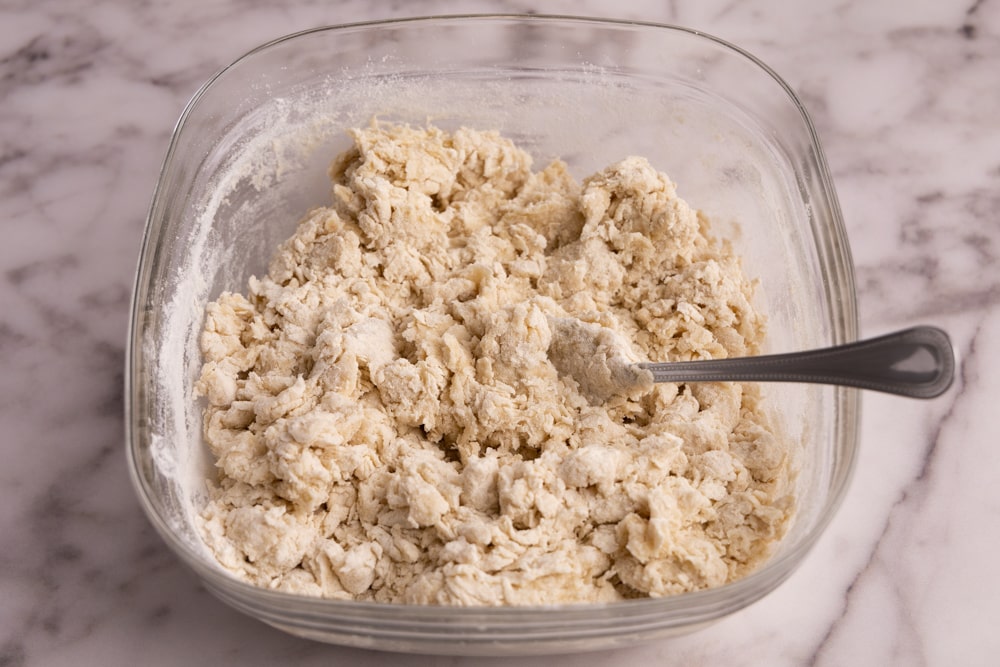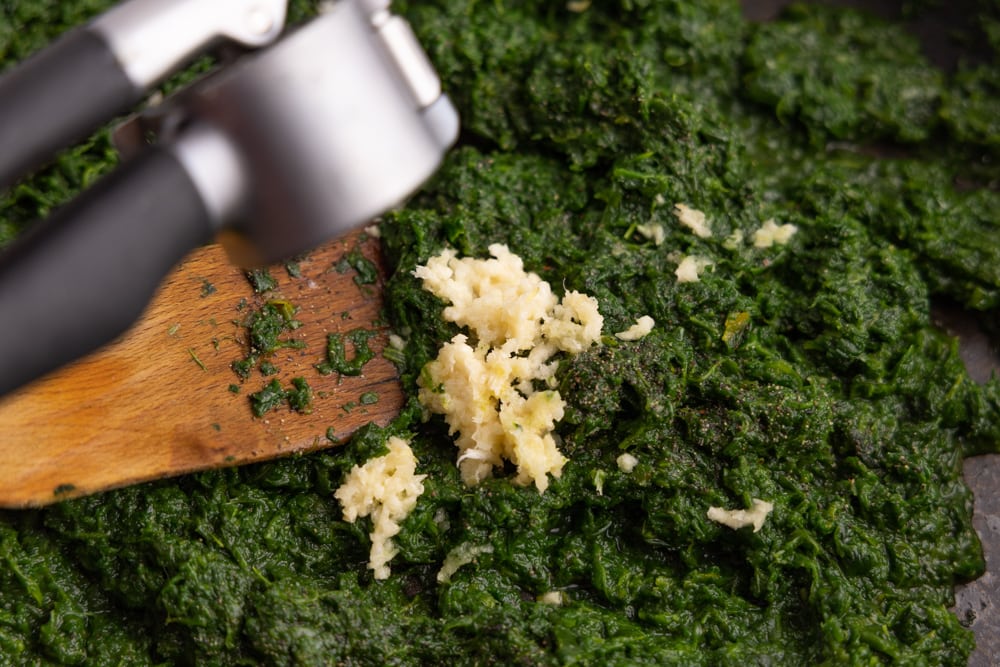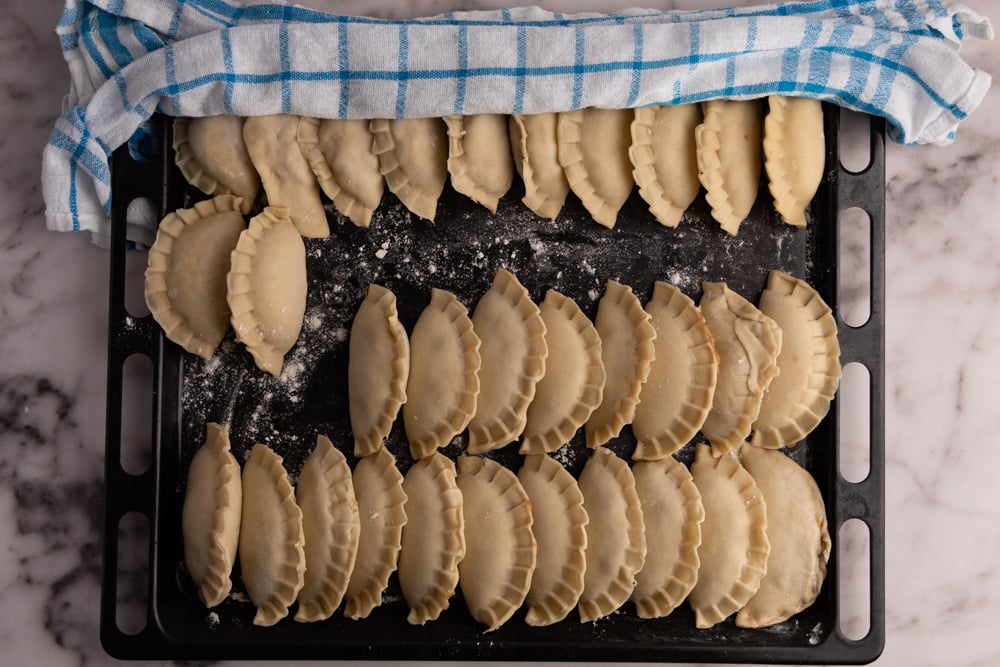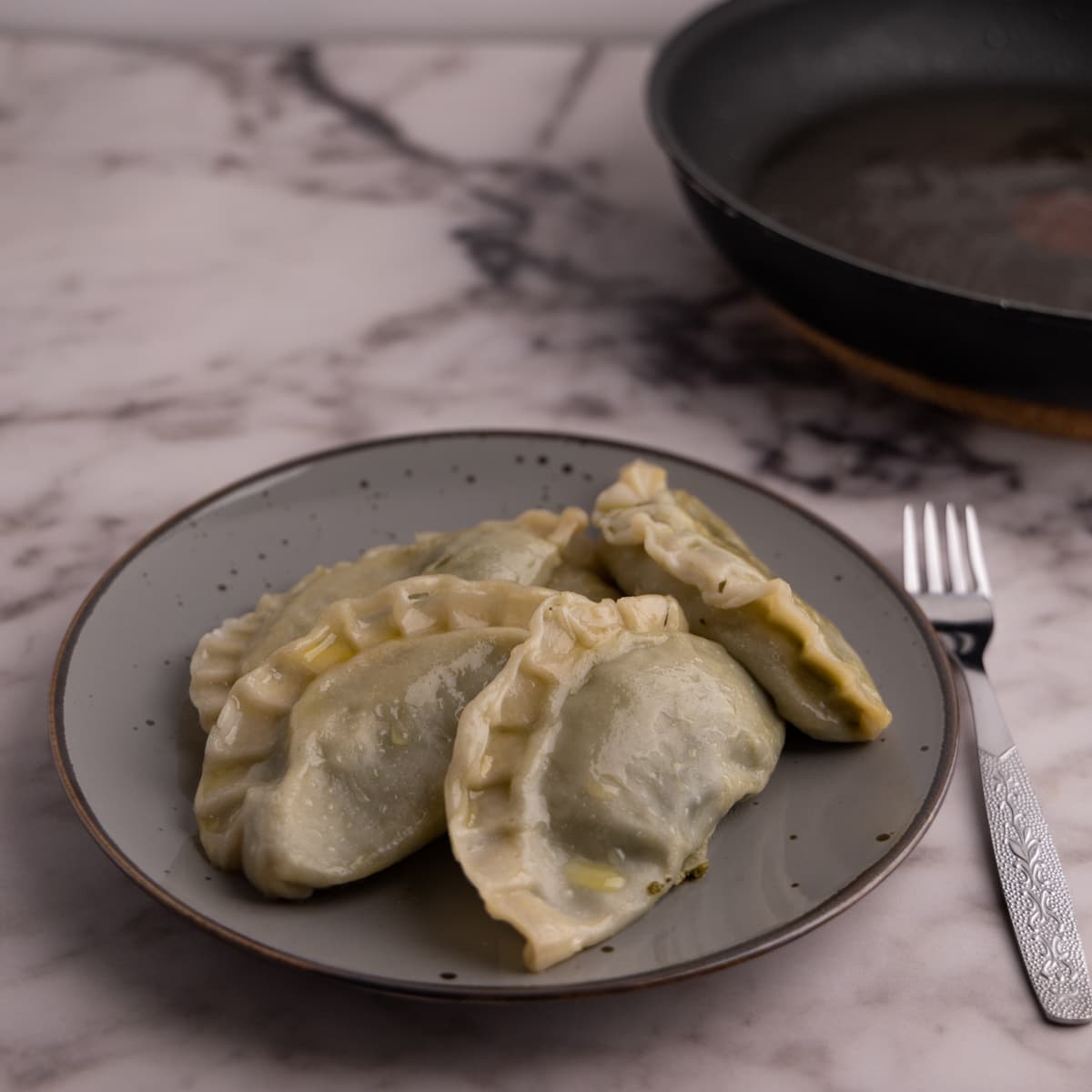Spinach Pierogi Recipe
A flavorful spinach, garlic, and feta filling. Make extra and freeze for a quick meal later.
This post may contain affiliate links. Read our privacy policy.
This spinach pierogi recipe combines the flavors of spinach, garlic, and feta for a delicious twist on traditional pierogi.
(Don’t worry, I cover subbing in cream cheese and making a vegan version, too.)
Whether you’re a pierogi lover testing new flavors or looking for a different way to enjoy spinach, this recipe is worth the effort.
Recipe Info
This recipe:
- Combines spinach, feta, and garlic for the filling. If garlicky spinach is your thing, you’ll love this combo. No feta on hand? Cream cheese works perfectly as a substitute.
- Can be made vegan. Skip the feta or cream cheese and stick to the garlicky spinach for a simple, yet delicious filling.
- Takes about 2 hours to make. From preparing the pierogi dough to cooking the spinach filling, rolling and filling the dough, and finally cooking the pierogi, you’re looking at a 2-hour process from start to finish. Plan accordingly.
- Freezes well. Doubling the recipe adds only about 50% more work, so make a big batch and freeze some for later.
If you’re making spinach pierogi for the first time, read the ingredients notes, step-by-step instructions, and tips. If you’re a veteran, feel free to jump to the recipe card.
Extra Learning
Before we jump in, here are a few handy resources to help you nail this recipe:
- Homemade Pierogi for Beginners. My pierogi guide that walks you through the pierogi making process, start to finish. Whether you’re new to pierogi or just need a refresher, this guide has you covered.
Ingredients and Substitutes
Pierogi Dough

- Flour. Use all-purpose flour. If you use something like bread flour or whole wheat flour, you will need noticeably more liquid to achieve the right dough texture.
- Oil. Use a neutral-flavored oil, such as your regular cooking oil. Avoid olive oil as it can be bitter, which may affect the dough’s flavor.
- Salt. Use fine-grained salt for best results.
- Water. Plain boiled water is all you need; no need to be fancy here.
Spinach Pierogi Filling

- Spinach. Frozen chopped spinach is the best option because it’s already cut and you can just throw it into the skillet and wait a few minutes until it melts. If you’re using fresh spinach, chop it before you cook it.
- Salt. I use fine-grained salt, but any other should do too.
- Pepper. Regular ol’ black pepper is all you need.
- Feta Cheese. Feta cheese and spinach complement each other well, so using feta is what I recommend. However, if you don’t enjoy feta’s tangy and acidic taste, you can substitute it with cream cheese. The flavor will be more mellow, and it’s more likely that you will have cream cheese in your fridge. Alternatively, you can combine half feta and half cream cheese for something that’s in-between flavor-wise.
- Garlic. Spinach and garlic are a classic combination. If you love garlic, add more cloves than the recipe calls for. And if you don’t have fresh garlic, you can use garlic powder instead. Add a teaspoon when cooking the spinach, and taste for flavor after adding and melting the cheese.
- Butter. I like cooking spinach in butter, but if cooking oil or olive oil is your jam, feel free to use it instead.
Step-By-Step: How to Make Spinach Pierogi
Step 1: Make Dough
(Read more about this in our recipe.)
- Boil a pot of water.
- Sift flour into a large bowl. Sifting probably isn’t necessary, but I recommend it anyways. Plus, it’s something you can do while waiting for the water to boil.

- Add salt and mix. Just a quick stir to spread the salt.
- Add oil and boiled water.

- Mix. Mix the ingredients by stirring with a regular tablespoon or a large wooden spoon. Be careful not to burn yourself, as you will be working with water that was boiling just a few moments ago. Stir until you reach the point where there is no visible water in the bowl, then switch to using your hands.

- Knead. Start slowly and make sure the dough isn’t too hot to handle. Knead until you have incorporated all the flour into a homogeneous dough ball, which usually takes 4 to 8 minutes.
 Kneading in progress. Note that there’s still flour left in the bowl.
Kneading in progress. Note that there’s still flour left in the bowl. Dough ready – all the flour is incorporated and the dough is pretty homogenous.
Dough ready – all the flour is incorporated and the dough is pretty homogenous.
- Wrap and rest. Wrap the dough ball tightly in plastic wrap and let it rest for about 30 minutes before continuing. This will allow the dough to relax and become easier to work with.

- Make pierogi. Once that half an hour of waiting is over, the dough is ready for rolling and making pierogi.

Step 2: Prep Filling
- Thaw frozen spinach. Place a non-stick skillet on low heat and add a tablespoon of butter or oil. Once the butter has melted, add the frozen spinach and let it thaw slowly. If the frozen garlic starts to scorch, add a bit more fat or water.

- Add salt, pepper, and garlic. Peel and mince or crush the garlic cloves. Once most of the water has evaporated from the spinach (i.e., it’s almost cooked), add the salt, pepper, and garlic to the skillet. Stir to combine.

- Stir in feta cheese. Dice or crumble the feta and add it to the garlicky spinach, then stir. Cook and stir until the cheese starts to melt and form a cohesive paste with the spinach.

- Adjust the flavor. Taste the cooked filling and add more salt, pepper, or acid (such as lemon juice or apple cider vinegar) if needed. I usually don’t add anything at this point, but if you’re using cream cheese instead of feta, you might need extra salt or acid to adjust the flavor.

- Set aside to cool. Take the filling off the heat and let it cool down for at least 20 minutes before proceeding. This will allow any extra water to evaporate.
Step 3: Combine
- Divide. Divide the pierogi dough into two or three parts. Take one part and spread it on a floured work surface, then roll it out until it’s nice and thin. Be careful not to roll it too thin, as it may tear when you form the pockets and seal the dough around the filling. Wrap the rest of the dough tightly to prevent it from drying out.

- Cut into circles. Cut palm-sized circles in the rolled pierogi dough. Anything round with a somewhat sharp edge is great, but a simple glass or mason jar works as well. Or use your pierogi maker if you have one. Form a ball with the dough left over after cutting and use it when rolling out the rest of the pierogi.

- Fill dough. Place a spoonful of the filling in the middle of the dough circle, then fold the dough over the filling and press the edges together starting in the middle. Try to leave as little air as possible in the pocket you’re forming. To make a good seal, moisten the outer edge of the dough using a wet finger before pressing the edges together.
 Making a pocket with pierogi dough
Making a pocket with pierogi dough Forming spinach pierogi with hands
Forming spinach pierogi with hands Hand formed spinach pierogi
Hand formed spinach pierogi Forming spinach pierogi using a pierogi maker
Forming spinach pierogi using a pierogi maker Pierogi maker formed spinach pierogi
Pierogi maker formed spinach pierogi
- Cover with damp towel. Place each formed pierogi on a floured cookie sheet and cover them with a damp kitchen towel. The edges will dry out quickly otherwise. If you want to save space and let the pierogi touch each other, lightly brush the areas where they’ll touch with flour. This will prevent them from sticking together and causing the pierogi dough to tear when removed for boiling.

- Make more pierogies. Continue forming pierogi until you run out of dough or filling.
Step 4: Cook
- Boil water. Bring a large pot of salted water to a boil. I typically use one teaspoon of salt per quart of water but feel free to adjust the amount to your preferences.
- Add a few pierogi. Once the water is boiling, add a few pierogi to the pot and stir them to prevent them from sticking to the bottom. Once the pierogi start floating to the surface, simmer them gently for another 3 to 4 minutes. Make sure not to overcrowd the pot so that the pierogi don’t stick together or cook unevenly.

- Remove and serve. Remove the pierogi from the water using a slotted spoon and serve.

Recipe Tips
- Taste and Adjust: After cooking the filling, taste it and adjust the seasoning as needed. A flavorful filling is key to delicious pierogi—don’t settle for bland.
- Double the Batch: Save time by doubling the recipe. You can make more pierogi or use a different filling (here’s our list of pierogi fillings) for variety.
- Pan-Fry for Flavor: For added texture and flavor, pan-fry the boiled pierogi until golden brown on both sides.
- Rest for Extra Flavor: Pierogi typically taste even better the next day as the flavors meld.
- Chill Filling if Needed: If the filling is too soft, refrigerate it for at least 30 minutes to an hour to firm it up. Prepping the filling a day ahead and chilling overnight works great, too.
- Keep Water Handy: Use a small bowl of water to moisten the edges of the dough when forming pierogi. This ensures they seal properly.
- Handle Leftovers: Expect some leftover dough or filling, as the size and shape or your pierogi will be different than mine. Freeze excess dough or filling for future use. If there’s only a small amount of dough left, you can discard it.
- Boil While You Work: Start boiling water once you’ve used about half of the filling. Cook the pierogi in batches, dropping a few into the pot and stirring occasionally while continuing to roll and fill more dough. Keep an eye on the cooking pierogi to avoid overcooking.

Make it Vegan
To make this recipe vegan, omit the feta cheese and replace butter with olive oil.
This will create a similar flavor to this garlic sauteed spinach recipe, which can work well as a pierogi filling after blending or processing in a food processor.
If you enjoy garlicky spinach, you’ll enjoy it in the pierogi as well. Just remember to triple the amount of spinach so that you don’t run out of filling halfway through.
What to Serve With Spinach Pierogi
- Melted Butter: The simplest topping that’s ready in minutes. If you’re pan-frying your pierogi, pour any leftover butter from the pan over them for extra flavor.
- Sour Cream: A classic pierogi topping. A dollop of sour cream pairs wonderfully with spinach pierogi, especially if you’ve used cream cheese or skipped the cheese entirely. If you stick with feta, consider a milder alternative like yogurt to balance the flavors.
- Polish Kielbasa: For a heartier meal, serve your pierogi with sautéed or boiled Polish sausage. The smoky, savory flavors of kielbasa are a perfect match. Sauté with onions for added depth—just cook the onions for a few minutes before adding the sliced sausage.
- Other Options: Check out our pierogi toppings list for other ideas.

Storage
To store spinach pierogi, let them cool and dry individually on large plates.
After 15 to 20 minutes, flip them over to ensure that both sides dry evenly. Once completely dry, transfer them to an airtight container, arranging them in a single layer and ensuring they are not touching each other too much (a bit is okay) to avoid sticking together.
If you need to stack the pierogi, separate each layer with parchment paper or plastic wrap.
Made a double batch? Freeze leftover pierogi for a quick meal later on.
Reheating
To reheat spinach pierogi, start by heating a non-stick skillet over medium-low heat and add a few tablespoons of butter or oil to thinly coat the surface of the skillet.
Once the skillet is preheated, add the pierogi to the skillet, making sure not to overcrowd the pan. Next, cover the pierogi with a lid and cook them for 12 to 15 minutes, flipping them halfway through to ensure they heat evenly.
Be sure to shake the skillet every couple of minutes to prevent the pierogi from sticking to the bottom.
For a crispier texture, increase the heat slightly or leave the pierogi on the skillet for a bit longer, flipping them only after one side is nicely browned.
Similar Recipes to Try
Looking for more? Check out the following recipes:
- Polish lazy pierogi. These aren’t “real” pierogi, but they come together in 30 minutes (instead of 2 hours) and are a great option for a busy weeknight.
- Meat pierogi. Classic meat pierogi recipe that’s super versatile. I focus on chicken, turkey, beef, and pork, but less popular options work just as well.
- List of vegan pierogi recipes. Looking for a vegan-friendly pierogi recipe? That list has a bunch of options, both savory and sweet.
- List of pierogi fillings. Love pierogi? Find your next filling in my list of pierogi fillings.

Equipment
Ingredients
Pierogi Dough
- 2 cups all-purpose flour ~250g
- ¼ tsp salt
- 1 ½ tbsp oil
- ½ cup boiling water ~120ml
Spinach Pierogi Filling
- 1 pound frozen spinach ~450g
- 7 oz feta cheese or cream cheese
- 3 tablespoons butter or oil
- 3 garlic cloves
- ¼ teaspoon salt
- ¼ teaspoon pepper
Instructions
Make Dough
- Boil Water: Boil a pot of water.½ cup boiling water
- Sift Flour: Sift flour into a large bowl.2 cups all-purpose flour
- Add Salt: Add salt and mix.¼ tsp salt
- Wet Ingredients: Add oil and boiled water.1 ½ tbsp oil
- Mix Ingredients: Mix the ingredients by stirring with a spoon. Be careful not to burn yourself. Once there is no visible water in the bowl, use your hands to knead the dough until it is a homogeneous ball.
- Wrap and Rest: Wrap the dough ball tightly in plastic wrap and let it rest for about 30 minutes before continuing.
- Make Pierogi: Once the wait is over, the dough is ready for rolling and making pierogi.
Prep Filling
- Prep Spinach: Melt butter in a non-stick skillet, add frozen spinach, and thaw. Add more fat or water if needed.1 pound frozen spinach, 3 tablespoons butter
- Add Spices: Add minced garlic, salt, and pepper to the skillet once the spinach water has evaporated. Mix well.3 garlic cloves, ¼ teaspoon salt, ¼ teaspoon pepper
- Add Cheese: Add diced feta to the spinach mixture, cook until cheese melts and forms a paste with spinach.7 oz feta cheese
- Season: Taste the filling, adjust salt, pepper, or acid if needed, especially if using cream cheese.
- Cool: Let the filling cool for 20 minutes to evaporate extra water before using.
Combine
- Roll Out Dough: Divide the pierogi dough into two or three parts. Then, spread one on a floured work surface and roll it out until it's thin. It shouldn't be super thin so that you can still stretch it when forming the pockets.
- Cut Dough: Cut palm-sized circles in the rolled pierogi dough using a cookie cutter or glass.
- Fill: Place a spoonful of spinach filling in the center of each dough circle. Fold the dough over the filling and press the edges together, starting in the middle. Leave as little air as possible in the pocket you're forming. To help form a good seal, moisten the outer edge of the dough using a wet finger.
- Store: Place each formed pierogi on a floured cookie sheet and cover them with a damp kitchen towel.
Cook
- Boil Water: Bring a large pot of salted water to a boil. I typically use one teaspoon of salt per quart of water but feel free to adjust the amount to your preferences.
- Cook: Once the water is boiling, add a few pierogi to the pot and stir them to prevent them from sticking to the bottom. Once the pierogi start floating to the surface, simmer them gently for another 3 to 4 minutes. Make sure not to overcrowd the pot so that the pierogi don't stick together or cook unevenly.
- Serve: Remove the pierogi from the water using a slotted spoon and serve immediately with your favorite toppings.








I tried spinach and feta pierogi while I was in Poland and mmmmm so delicious!! I’m going to try making some..thank you for recipe xx
Great idea for a filling for Pierogis. Thanks for posting it.
Everyone loved it.
Thanks Dan! I’m happy you liked it.